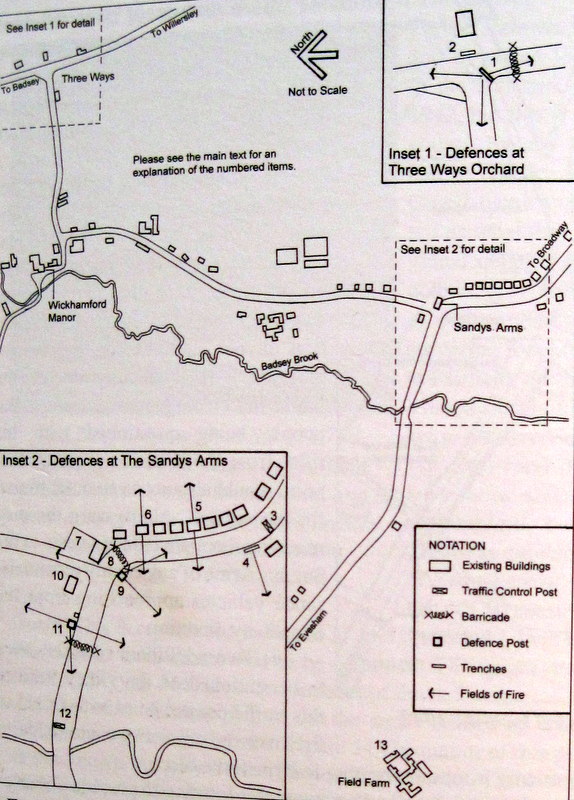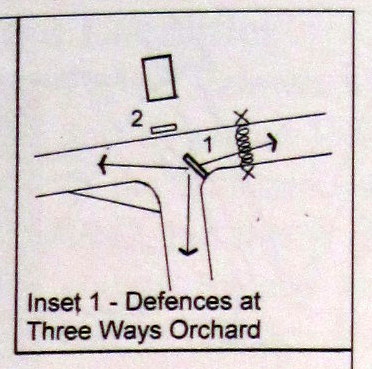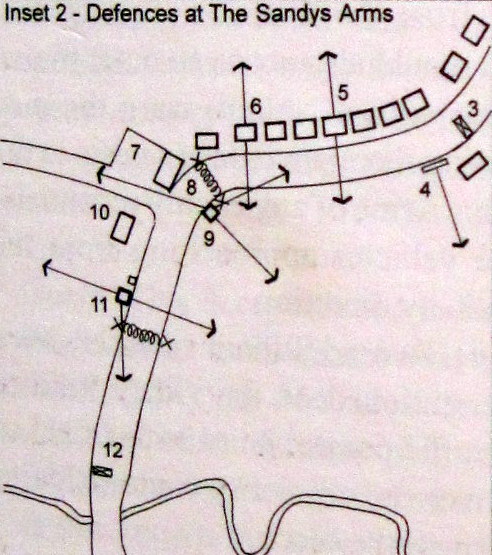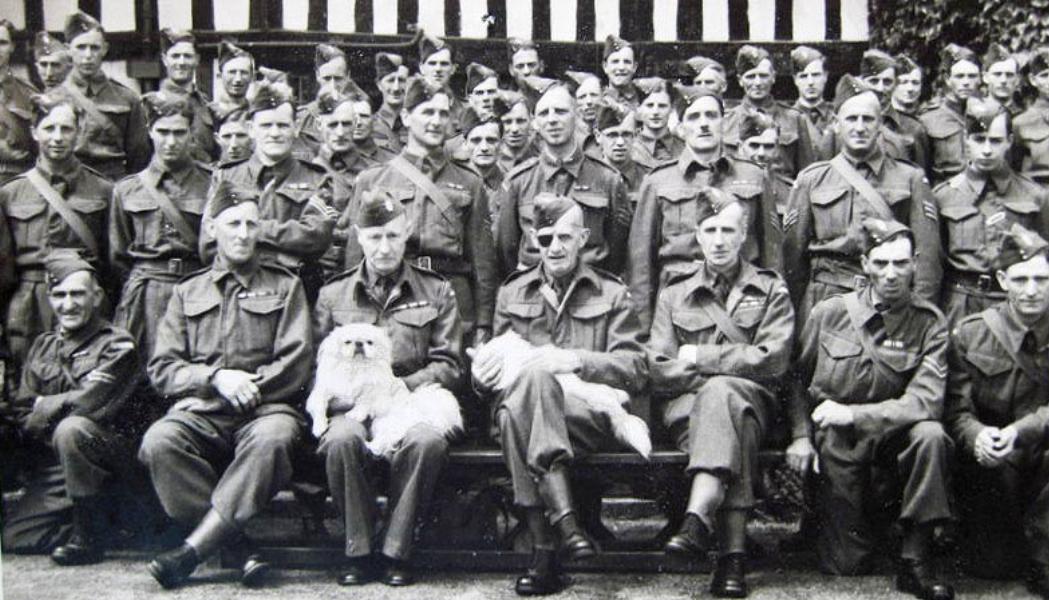During the early part of World War II, with a German invasion quite feasible, Lieut. H. T. Horsfield, Home Guard Platoon Commander, produced a plan for the defence of Wickhamford, centred on the Sandys Arms. This plan is the only one found so far for a small village in Worcestershire, but it does illustrate the methods and extent of defences that must have been a feature of the web of defence pattern throughout the remainder of the county. The detailed description of the defence positions involves the deployment of 35 men.
The sketch maps below are numbered to show the defence positions described in the rest of this article.

-
Two men were to man what is described as ‘the barricade’, at Three Ways Orchard, at the junction of Willersey Road and Golden Lane. No details of the form of the barricade are available but the original illustration implies a barbed wire barrier, possibly supplemented by anti-tank cylinders that were widely used in other parts of the county. The siting of this roadblock suggests an enemy attack from the south, via Willersey, was expected. To protect the riflemen manning this post when under attack, a wall was constructed across the wide grass verge on the south-west corner of this junction. No details are available but a sandbagged breastwork with loopholes and capable of being used in either direction seems likely from the indicated fields of fire on the original plan.

-
A reserve of four riflemen for the Three Ways Post were to be stationed in front of the house adjoining the road junction and it is likely that a fire trench would have provided for their protection.
-
Described as a traffic control point on the original plan, this probably involved the use of a barricade to draw traffic to a halt and was to be manned by two riflemen. Typically one of the men would have questioned anyone approaching the barrier and check their identity documents while his colleague would cover the people being questioned, from the roadside. This control point would also act as an outer piquet for the village, able to warn men manning the main defence posts at the Sandys Arms of any enemy reconnaissance vehicles approaching from the Broadway direction.
-
Two additional riflemen were to be stationed on the village side of this traffic control point with a field of fire over the adjoining countryside to the west, in order to deal with any enemy troops attempting to by-pass the block.
-
Two riflemen were to occupy the semi-detached Council houses at this location to provide observation and fields of fire over the countryside to the front and rear. No doubt upstairs windows would have been used for this purpose.

-
The same arrangements were made for this house nearer the Sandys Arms.
-
A reserve of seven riflemen were to be stationed in the car park at the rear of the Sandys Arms in readiness to make their way to defence posts at the rear of the house at No 6 on the defence map. This arrangement implies that an attack from Broadway direction was expected and that enemy troops would attempt to bypass the blocks on the main road.
-
The garrison commander intended to station himself at the front of the Sandys Arms in order to direct the defence of the two main roadblocks here. A one-man trench in the grass verge in front of the pub would seem to be likely provision for this exposed position or perhaps he would have conducted the battle from one of the pub windows, suitably sandbagged.
-
A defence post was located on the opposite side of the road to the pub and was to be manned by two riflemen and two ‘bombers’. Bomber was a World War 1 term for grenade thrower and their use here would imply that the defence post was an open-topped structure, probably a sandbagged square breastwork to provide all-round protection for the occupants against small-arms fire. The fields of fire indicate that the men here had responsibility for covering the barricade as well as the approaches from Broadway, from the village centre or across the field to the west.
-
One rifleman and one bomber were to be stationed in the house close to the road junction. A telephone box earmarked for Home Guard use was available and would have been used to alert the Evesham anti-tank island garrison of any enemy approach.
-
A second defence post occupied by two riflemen and two bombers was located close to the telephone call box, to cover the barricade and provide fire over the surrounding fields and towards the traffic control point on the Evesham side of the village.
-
A traffic control point was established on the village side of Badsey Brook bridge, to be manned by two riflemen.
-
One rifleman was to be stationed in Field Farm and, although no indication is given on the original defence plan of his role, it is likely that he would have been an observer/sniper able to report to his Company and Battalion commanders progress on the battle of Wickhamford and pick off any small parties of enemy troops infiltrating through the surrounding fields towards the village.
Fortunately, it is a matter of conjecture as to whether the brave men of Wickhamford would have been able to delay any German attack for very long, but they deserve all credit for being willing to put their lives on the line in the defence of our country.
Further information on the local Home Guard can be found in the article The 4th Worcestershire (Evesham) Battalion Home Guard, which contains many photographs of the Broadway and other Platoons and a history of the Battalion from its formation in 1940 to its stand-down in 1944.

Major Lees-Milne. with eye patch, is in the centre and Lieut Horsfield (who devised the defence plan) is to his left; they are pictured outside of Wickhamford Manor.
Acknowledgement – All of the details of the defence of Wickhamford are copied from the excellent book by Mick Wilks, The Defence of Worcestershire and the southern approaches to Birmingham in World War II (Logaston Press, 2007).
We are very grateful for Mick Wilks’ permission to copy the relevant section of his book for this article.
Tom Locke – October 2013
